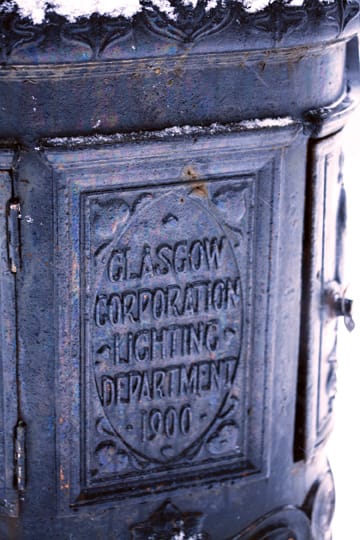Point Pleasant's lamps help shed light on an old-world connection and charm
BEFORE 2865, Halifax Regional Municipality will have to renegotiate its arrangement with the Crown if the public is to continue enjoying Point Pleasant Park, at the southern tip of the Halifax peninsula. That's the year the city's 999-year lease with Queen Victoria expires, assuming the requisite one-shilling payments are made annually.
The wooded walking trails, outdoor theatre and harbour views are the features most people associate with the park; probably not as well known are the five iron lamps that light the way at its Tower Road entrance. These lamps, which once lit a streetscape in Glasgow, Scotland, were given to Halifax during Canada's Centennial Year by Major-General Kenelm C. Appleyard, an industrial engineer originally from Surrey, England. Appleyard is credited with involvement in many Halifax-area development projects before his death, just six months after the lamps were installed, in July 1967.
The bases of the 20-foot light standards are embossed with images depicting over-sized leaves, trees, small human figures in fez-like hats and robust, leaping fish. Atop the poles are swirling, curling lamp brackets that exhibit the creativity of Victorian-era designers, iron being a staple of street hardware after first emerging during the Industrial Revolution.

The light standards were a topic of some debate in the February 1967 meeting of the Point Pleasant Park directors-one member felt their installation would serve "no useful purpose." But the mayor, the park superintendent and the city manager disagreed, the latter declaring that the lamps were quite in keeping with the park's "rural setting." As a result city council voted to appropriate $3,140 for their installation.
Perhaps all those in favour knew something about the tradition of Point Pleasant Park-that many things Scottish already constituted much of the site's heritage.
Edinburgh native Janet Kitz, who collaborated on the 1999 book, Point Pleasant Park-An Illustrated History, immigrated to Canada in 1971 from Scotland after meeting her late husband, Leonard Kitz, at the famed Edinburgh Festival. The day after Janet arrived, Leonard took her to the park. "I think I've been there every day since," Janet says. She wasn't just smitten with her new Canadian beau; she actually felt an immediate and lingering kinship to the park. "I was charmed to see all these things that reminded me of home," she says.
Among the most prominent are the wrought iron gates that welcome visitors to the entrance of what was once known as Tower Woods Park, long before the name Point Pleasant took hold. The gates were donated by Sir William Young, himself a Scot and the person responsible for convincing the Crown to alter the proposed 1866 lease from 99 to 999 years. Although they were originally to come from Young's homeland, the gates were actually made by Star Manufacturing, in nearby Dartmouth, NS, based on designs reminiscent of those found at the time in Glasgow.
Two 1883 wrought iron shelters still found in the park, known as summerhouses or referred to as pavilions by their donor, businessman William West, also came from the old country. And many of the stonemasons who worked in the park and elsewhere in Halifax were from Scotland.
Janet relays stories about the swaths of Scottish heather-not native to Nova Scotia-found throughout Point Pleasant. One version says that Scottish sailors who'd stuffed their mattresses with heather emptied them upon arriving in the New World. Another yarn claims that homesick Scots planted the heather out of nostalgia, as they did with the non-native beech and horse chestnut trees in the park.
 But it's the lamps that serve to attract the layman's eye, as well as the lens of photographers. They were manufactured of cast and wrought iron by Walter MacFarlane and Company of Glasgow, where they were stamped "Glasgow Corporation Lighting Department 1900." The MacFarlane Foundry was one of the most important manufacturers of ornamental ironwork in Scotland, producing everything from lamps to fountains, gates, fences, stair railings, building domes and public urinals. Photographs of the lamps and original MacFarlane design illustrations are featured in the 1982 book Iron (University of Toronto Press), which covers the history of cast and wrought iron in Canada from the 17th century to modern day.
But it's the lamps that serve to attract the layman's eye, as well as the lens of photographers. They were manufactured of cast and wrought iron by Walter MacFarlane and Company of Glasgow, where they were stamped "Glasgow Corporation Lighting Department 1900." The MacFarlane Foundry was one of the most important manufacturers of ornamental ironwork in Scotland, producing everything from lamps to fountains, gates, fences, stair railings, building domes and public urinals. Photographs of the lamps and original MacFarlane design illustrations are featured in the 1982 book Iron (University of Toronto Press), which covers the history of cast and wrought iron in Canada from the 17th century to modern day.
Janet's collaborator on Point Pleasant Park was Halifax photographer Gary Castle, who has long been fascinated with the lamps, imagining novel ways of photographing them. What makes the lamps unique, says Gary, is that they're still functional. Elsewhere, such as in Halifax's Public Gardens, iron poles "with the tops off them" act as reminders of street lamps from a bygone era.
The park's lease, meanwhile, remains in effect, with 857 years to go-with stipulations that if necessary, the site can be used for "purposes defensive or offensive, including the erection of new forts and batteries." The park was once home to several artillery batteries, but whether the lamps shed any new light on these activities remains to be seen.
